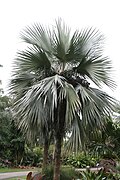| Latania | |
|---|---|
 | |
| Red latan palm | |
| Scientific classification | |
| Kingdom: | Plantae |
| Clade: | Tracheophytes |
| Clade: | Angiosperms |
| Clade: | Monocots |
| Clade: | Commelinids |
| Order: | Arecales |
| Family: | Arecaceae |
| Tribe: | Borasseae |
| Genus: | Latania Comm. ex Juss. |
| Type species | |
| Latania lontaroides | |
| Synonyms [1] | |
| |
Latania, commonly known as latan palm or latania palm, is a genus of flowering plant in the palm tree family, native to the Mascarene Islands in the western Indian Ocean. [1] [2]







